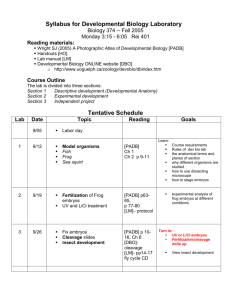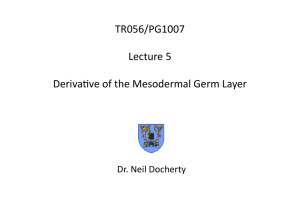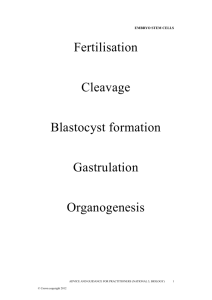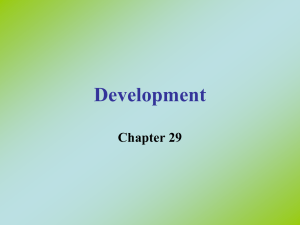151
advertisement
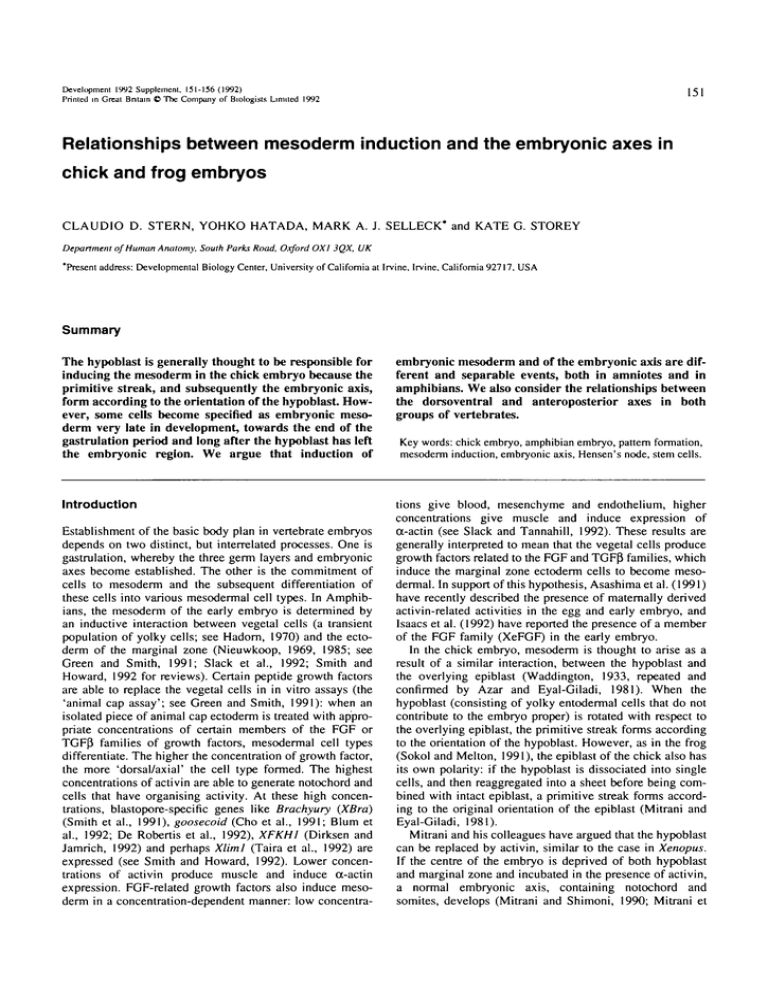
Development 1992 Supplement, 151-156(1992)
Printed in Great Britain © The Company of Biologists Limited 1992
151
Relationships between mesoderm induction and the embryonic axes in
chick and frog embryos
CLAUDIO D. STERN, YOHKO HATADA, MARK A. J. SELLECK* and KATE G. STOREY
Department of Human Anatomy, South Parks Road, Oxford 0X1 3QX, UK
'Present address: Developmental Biology Center, University of California at Irvine, Irvine, California 92717, USA
Summary
The hypoblast is generally thought to be responsible for
inducing the mesoderm in the chick embryo because the
primitive streak, and subsequently the embryonic axis,
form according to the orientation of the hypoblast However, some cells become specified as embryonic mesoderm very late in development, towards the end of the
gastrulation period and long after the hypoblast has left
the embryonic region. We argue that induction of
embryonic mesoderm and of the embryonic axis are different and separable events, both in amniotes and in
amphibians. We also consider the relationships between
the dorsoventral and anteroposterior axes in both
groups of vertebrates.
Introduction
tions give blood, mesenchyme and endothelium, higher
concentrations give muscle and induce expression of
a-actin (see Slack and Tannahill, 1992). These results are
generally interpreted to mean that the vegetal cells produce
growth factors related to the FGF and TGFfJ families, which
induce the marginal zone ectoderm cells to become mesodermal. In support of this hypothesis, Asashimaet al. (1991)
have recently described the presence of maternally derived
activin-related activities in the egg and early embryo, and
Isaacs et al. (1992) have reported the presence of a member
of the FGF family (XeFGF) in the early embryo.
In the chick embryo, mesoderm is thought to arise as a
result of a similar interaction, between the hypoblast and
the overlying epiblast (Waddington, 1933, repeated and
confirmed by Azar and Eyal-Giladi, 1981). When the
hypoblast (consisting of yolky entodermal cells that do not
contribute to the embryo proper) is rotated with respect to
the overlying epiblast, the primitive streak forms according
to the orientation of the hypoblast. However, as in the frog
(Sokol and Melton, 1991), the epiblast of the chick also has
its own polarity: if the hypoblast is dissociated into single
cells, and then reaggregated into a sheet before being combined with intact epiblast, a primitive streak forms according to the original orientation of the epiblast (Mitrani and
Eyal-Giladi, 1981).
Mitrani and his colleagues have argued that the hypoblast
can be replaced by activin, similar to the case in Xenopus.
If the centre of the embryo is deprived of both hypoblast
and marginal zone and incubated in the presence of activin,
a normal embryonic axis, containing notochord and
somites, develops (Mitrani and Shimoni, 1990; Mitrani et
Establishment of the basic body plan in vertebrate embryos
depends on two distinct, but interrelated processes. One is
gastrulation, whereby the three germ layers and embryonic
axes become established. The other is the commitment of
cells to mesoderm and the subsequent differentiation of
these cells into various mesodermal cell types. In Amphibians, the mesoderm of the early embryo is determined by
an inductive interaction between vegetal cells (a transient
population of yolky cells; see Hadorn, 1970) and the ectoderm of the marginal zone (Nieuwkoop, 1969, 1985; see
Green and Smith, 1991; Slack et at., 1992; Smith and
Howard, 1992 for reviews). Certain peptide growth factors
are able to replace the vegetal cells in in vitro assays (the
'animal cap assay'; see Green and Smith, 1991): when an
isolated piece of animal cap ectoderm is treated with appropriate concentrations of certain members of the FGF or
TGF(i families of growth factors, mesodermal cell types
differentiate. The higher the concentration of growth factor,
the more 'dorsal/axial' the cell type formed. The highest
concentrations of activin are able to generate notochord and
cells that have organising activity. At these high concentrations, blastopore-specific genes like Brachyury (XBra)
(Smith et al., 1991), goosecoid (Cho et al., 1991; Blum et
al., 1992; De Robertis et al., 1992), XFKHI (Dirksen and
Jamrich, 1992) and perhaps Xliml (Taira et al., 1992) are
expressed (see Smith and Howard, 1992). Lower concentrations of activin produce muscle and induce a-actin
expression. FGF-related growth factors also induce mesoderm in a concentration-dependent manner: low concentra-
Key words: chick embryo, amphibian embryo, pattern formation,
mesoderm induction, embryonic axis, Hensen's node, stem cells.
152
C. D. Stern and others
al., 1990b). Mitrani et al. (1990b) conclude that the
hypoblast may be the endogenous source of activin in the
embryo and that it may secrete this factor in a graded way,
with the highest concentrations being emitted at its posterior midline. However, although it is clear from these
experiments and others (e.g. Mitrani et al., 1990a; Cooke
and Wong, 1991) that the chick epiblast can respond to
activin and FGF, there is as yet no direct evidence that these
molecules can act as true mesoderm-inducing factors on the
chick epiblast (see Slack, 1991). One reason for this is that
mesodermal differentiation of chick epiblast cells cannot
yet be assessed independently from formation of an embryonic axis.
Induction of the mesoderm and Its dorso-ventral
subdivision still continue throughout gastrulation
In Xenopus, it has been suggested that mesodermal cell
diversity is generated prior to the establishment of an overt
body plan. Different mesoderm types are segregated, such
that there is a transition from dorsal mesoderm (e.g. notochord) to ventral (blood, endothelium) across the marginal
zone. The 'three signal model' (Slack et al., 1984), proposed to explain both the induction of mesoderm and its
subdivision into different dorsoventral cell types, suggests
that a ventral vegetal (VV) signal (perhaps FGF) instructs
ventral marginal zone cells to become mesodermal. A
second, dorsal vegetal (DV) signal, emanating from a small
group of cells (the 'Nieuwkoop centre') in the most dorsal
part of the vegetal hemisphere, instructs the most dorsal
marginal zone cells (the site of the future dorsal lip of the
blastopore) to become 'Spemann organizer' cells. These
cells would emit an organizing (O) signal, which subdivides
the marginal zone mesodermal belt into different dorsoventral cell types, according to their distance from the Spemann organizer. Later in development, the Spemann organizer cells emit neural inducing signal(s), instructing the
neighbouring animal cap ectoderm to become neural.
The competence of Xenopus animal caps to respond both
to vegetal cells and to mesoderm-inducing factors like FGF
and activin declines at the beginning of gastrulation (stage
9-10; see Gurdon, 1987; Green and Smith, 1991; Slack and
Tannahill, 1992). However, at least some individual cells
in the amphibian dorsal lip (Delarue et al., 1992) and chick
Hensen's node (Selleck and Stern, 1991) still give rise to
progeny that are located in both ectoderm and mesendoderm at the end of gastrulation. Clearly, these cells cannot
have been induced to form mesoderm before gastrulation.
Therefore, some mechanisms inducing mesoderm must still
operate at the end of the gastrula stage, even though the
competence of cells to respond to known mesoderm-inducing factors has all but disappeared by this stage.
The mesoderm also retains its ability to be regionalized
into different dorsoventral cell types at least until the start
of neurulation. Single cells can contribute to notochord and
somites at this stage (Selleck and Stern, 1991), and cells
located at the posterior end of the paraxial mesoderm can
contribute both to somites and to more lateral/ventral mesoderm (mesonephros, endothelium, blood; Stem et al., 1988).
Grafts of Hensen's node from a late primitive streak stage
quail embryo into the lateral part of a similarly staged chick
host embryo can produce paraxial (somite) and lateral
mesoderm from the host, although the degree to which
somites form depends on distance from the host axis (Hornbruch et al., 1979). Whether these somites form from the
lateral plate of the host or from newly induced mesoderm
remains to be established, but these experiments show that
the competence of the mesoderm to become subdivided into
dorsoventral regions has not completely disappeared before
the end of gastrulation. Taken together, these conclusions
suggest that, at least in the chick, commitment of mesoderm cells is still occurring at the start of neurulation. By
this time, the hypoblast has been displaced into extraembryonic regions and is therefore unlikely to be responsible
for mesoderm induction or for its regionalisation at these
stages.
Thus, mesoderm induction seems to occur over a protracted period of development, in more than one step, and
more than one signal must be involved.
Anteroposterior patterning of the mesoderm:
evidence for stem cells in Hensen's node
As well as producing a diversity of mesodermal cell types,
generation of the basic body plan requires the axes of the
embryo to become established. We have seen that in fate
maps of Hensen's node, some cells contribute progeny to
notochord only, some to somite only and others to both
notochord and somite (Selleck and Stern, 1991; see above).
But single cell lineage analysis in Hensen's node also
revealed an otherwise unsuspected spatial organisation of
the mesodermal descendants of the marked cells. Injection
of the fluorescent lineage tracer lysine-rhodamine-dextran
(LRD) into a single cell in the node generates several clusters of labelled cells, regularly spaced along the length of
the notochord or somitic mesoderm (Selleck and Stern,
1991, 1992a, b; Fig. 1). The spacing between clusters differs in the two tissues: in the notochord, clusters are separated by about 1.5-2 somite lengths, whilst in the somitic
mesoderm the distance appears to be about 5-7 somites. The
results have been interpreted as indicating that the node
contains a population of multipotent cells with stem cell
properties, which give rise to founder cells with more
restricted fates (viz. notochord or somite; Selleck and Stern,
1992b; Fig. 2). The founder cells also have stem cell properties; to account for the differences in spacing between
adjacent clusters, the rate of cell division is proposed to be
faster in notochord founder cells than in somitic precursors.
The distance of 5-7 somites between adjacent clusters in
the somitic mesoderm agrees well with the findings of Primmett and colleagues (Primmett et al., 1988, 1989; Stern et
al., 1988). They found that heat shock generates periodic
anomalies in the somitic mesoderm, with a spacing of about
6-7 somites, and that this periodicity correlates directly with
the rate of cell division of somite precursor cells. Indeed,
somite precursors in the segmental plate mesoderm divide
about every 10 hours, which is the time taken for about 7
somites to form (Primmett et al., 1989). These experiments
suggest that the anteroposterior axis of the mesoderm
becomes regionalised in the notochord and somite precur-
Chick and frog mesoderm induction and axis formation
153
inject single cell in Hensen's node
with lysine-rhodamine-dextran (LRD)
incubate embryo 48 h
Oh
cell in
Hensen's
node
39 h
sclerotome/
dermomyotome
differentiation
30 h
somite
formation
7 somites
48h
7 somites
spacing in notochord:
1.5-2 somites
Fig. 1. Diagram summarising periodic clusters of cells revealed by injection of lysine-rhodamine-dextran (LRD) into a single cell in
Hensen's node, based on the results of Selleck and Stern (1991, 1992a,b and unpublished observations). The spacing between clusters of
labelled cells in the somitic mesoderm is about 6 somites; this is correlated with a time scale following the fate of the somitic descendants
of the injected cell over 2 days after leaving Hensen's node. In the notochord, the clusters of descendants of the injected cell are 1.5-2
somite-lengths apart.
sor cells in the node, in association with the cell division
cycle of these progenitor cells.
Relationships between the anteroposterior and
dorsoventral axes
Several experiments have revealed effects of mesoderminducing factors on development of the anteroposterior axis
of the early embryo. For example, when dominant-negative
mutants are constructed for the FGF receptor in Xenopus
(Amaya et al., 1991), not only is the ventral mesoderm
affected, but also the posterior part of the embryo is deficient or fails to develop. For this reason, as well as the finding that activin-treated explants placed in the blastocoele of
a host embryo ('Einsteckung' assay) can generate head
structures whilst FGF-treated explants only generate tails
(Ruiz i Altaba and Melton, 1989; Sokol and Melton, 1991;
Slack and Tannahill, 1992), these results suggest that members of the FGF family are posterior inducers as well as
ventral inducers. Microinjection of mRNA encoding
goosecoid (Cho et al., 1991; De Robertis et al., 1992) or
members of the wnt family of proto-oncogenes (Smith and
Harland, 1991; Sokol et al., 1991) into ventral blastomeres
can also generate an ectopic axis.
Thus, there appears to be a correlation between the ability of a substance to induce dorsal mesoderm with its ability to generate head structures. Therefore, inducing factors
are often referred to as 'ventral/posterior' or 'dorsal/anterior' inducers (see Slack and Tannahill, 1992). But if the
same factors are responsible for posterior and ventral induction or for anterior and dorsal induction, how do these two
axes become separate in development?
Origin of posterior structures
Given the apparent relationship between anterior and dorsal,
and posterior and ventral, how do structures such as the
notochord (dorsal) of the tail (posterior) become established? In diagrams of the three signal model, the embryo
is often shown in mid-sagittal section (e.g. Slack et al.,
1984; see also Slack and Tannahill, 1992), with the ventral
region being thought of also as posterior. However, fate
maps of the early amphibian embryo (e.g. Hadorn, 1970;
Nieuwkoop et al., 1985; see also Keller et al., 1992) show
the presumptive tail bud region just above the equator,
about 90° away from the prospective ventral part of the
embryo (Fig. 3).
Classical fate maps of the chick blastoderm before the
appearance of the primitive streak (e.g. Rudnick, 1935; Pasteels, 1940; Waddington, 1956; Balinsky, 1975) seem to
place the presumptive tail at an equivalent, lateral position
close to the marginal zone (Fig. 3). Prior to and during the
early stages of primitive streak formation, 'Polonnaise'-like
movements of the epiblast make the left and right tail pri-
154
C. D. Stern and others
Fig. 2. A model of the organization
of stem cells and founder cells in
hours
Hensen's node of the chick embryo
0
FCC
at stage 3+. The median, anterior
FC n MSC
MSC
quadrant of the node contributes
cells to the notochord but not to the
FCr
somites, the regions lateral to the
primitive pit populate the medial
FCr
halves of the somites, and the region
between the previous two (shaded)
contributes to both notochord and
FCC
10
somites (Selleck and Stern, 1991).
Based on these results and those
summarised in Fig. 2, the following
scheme is proposed (see Selleck and
15
Stem, 1992b): the region that
contributes cells to both notochord
and somites (shaded) contains
multipotent stem cells (MSC) which
20
FC
s s
renew themselves and give rise to
founder cells that contribute
progeny to either the notochord
(FCn) or the somite (FC»). Each of
25
these founder cells also have stem
cell properties, since they can also renew themselves. The same model is displayed as a lineage tree on the right, n, notochord cells; s,
medial somite cells. In the lineage tree, the length of the vertical lines is proportional to the length of the cell division cycle of the cell
shown at the top of the line.
MSC
mordia converge towards the posterior margin, whilst the
cells that originally lay posteriorly in the marginal zone
shift forwards (see Stern, 1990). Some of these cells end
up in Hensen's node and subsequently contribute to the prechordal plate, definitive (gut) endoderm and chordamesoderm (see Selleck and Stern, 1991). Although the classical
fate maps mentioned above were produced mostly without
good lineage markers and before a good staging system was
available for pre-primitive streak stages of chick development (Eyal-Giladi and Kochav, 1976), they appear to be
remarkably accurate; recent studies in our laboratory (Selleck and Stem, 1991, 1992a; YH and CDS, in preparation)
confirm their conclusions.
Such fate maps of both chick and amphibian embryos,
indicate that: (a) presumptive head structures and prospective dorsal mesoderm are located close to each other, in the
region of Hensen's node or the dorsal lip of the blastopore
of the gastrula-stage embryo; (b) ventral mesoderm originates from a region which in the amphibian appears to be
located ventrally in the blastula; in the chick, the ventral
mesoderm seems to come from cells situated in the more
central epiblast, away from the marginal zone (see Stern
and Canning, 1990; Stern, 1992); (c) posterior ventral structures come from a region about 90° away from both the
prospective dorsal lip and ventral marginal zone in the
amphibian blastula, and from a marginal region about 90°
away from the posterior margin of the chick blastoderm.
But this still leaves us with the question: where are the
progenitors of the dorsal structures of the trunk and tail?
If, as we have discussed above, the node contains notochord and somite precursor cells with stem cell properties,
then the posterior notochord and somites will be derived
from progenitors common to more anterior notochord and
somites at the late primitive streak stage. Somehow, the
descendants of these progenitors must acquire their antero-
MSC
posterior positional information after this stage. One possibility is that such positional information is dependent on
the number of cell divisions undergone by stem cells before
each of their descendants leaves the node region. For example, the progenitor cells might become posteriorised by
exposure to some substance, like retinoic acid, present
locally within the node such that, the longer the time spent
in the node, the more posterior the character of their descendants.
One further piece of evidence supports this conclusion.
When Hensen's nodes of increasing age are grafted into the
area opaca of a competent host embryo, the anteroposterior
extent of the structures formed from the host depends on
the age of the node (see Storey et al., 1992; Kintner and
Dodd, 1991; for amphibians, see Spemann and Mangold,
1924; Nieuwkoop et al., 1985; Hemmati Brivanlou et al..
1990; Sharpe, 1990). The older the node, the more posterior
the structures that develop. However, host-derived structures only form if the transplanted node comes from a donor
embryo younger than the definitive streak stage. If the node
is older than this, the structures formed are derived from
self-differentiation of the grafted node; nevertheless, they
express the most posterior markers as if the grafted node
were able to pattern itself as far as the tail. This conclusion
is consistent with the idea that patterning posterior to the
otic vesicle (the level at which Hensen's node appears to
be located at the definitive streak stage; see Rudnick, 1935;
Balinsky, 1975) is related to the length of time spent by
progenitor cells within the node region.
Origin of the definitive (gut) endoderm, neural
induction and regionalisation
During the early stages of chick gastrulation, cells destined
Chick and frog mesoderm induction and axis formation
animal
155
Intermediate and lateral mesodermal components of the tail,
on the other hand, are recruited by the regressing primitive
streak from cells that have migrated towards the midline
during the early stages of gastrulation.
This brings us back to the original question: what is the
relationship between induction of the mesoderm and specification of the embryonic axes? Examination of fate maps
and analysis of other experimental findings can help us to
separate dorsal from anterior, ventral from posterior, and
all of the above from mesoderm induction. But we still have
to address the questions of when each of these axes is specified, and whether the role of the hypoblast in the chick and
of the vegetal tissue of the frog is mainly to induce mesoderm, to set up dorsoventral pattern or to specify the axes
of the embryo. Acknowledgement of the identity and location of these three embryonic dimensions could help us to
understand better the role of the so-called mesoderm-inducing factors in early vertebrate development.
Several discussions with Jeremy Green contributed greatly to
the development of some of our ideas about the origin of the tail
in the frog. We are also grateful to Marianne Bronner-Fraser for
her helpful comments on the manuscript.
References
Fig. 3. Presumptive dorsoventral and anteroposterior axes in the
fate maps of an amphibian late blastula (upper diagrams) and
chick blustoderm at about stage XI (lower diagram). The
amphibian map on the left shows the surface of the blastula
viewed from its left side, and the map on the right shows a similar
blastula observed from the animal pole. The chick blastoderm is
viewed from the epiblast side. D, dorsal; V, ventral; A, anterior; P,
posterior; E, yolky vegetal 'entoderm' (amphibian); e, surface
ectoderm. The arrows show the direction of some of the main cell
movements. In the upper left diagram, the presumptive tail region
is shown as a shaded area and the presumptive head is shown by
cross-hatching. In the chick diagram, the area opaca is shaded.
to form the tail bud in amphibians and birds converge from
the lateral margins to the future posterior margin, as we
have discussed above. At this time, presumptive definitive
endoderm cells become located close to precursors of the
notochord (Rudnick, 1935; Pasteels, 1940; Waddington,
1956; Rosenquist, 1966, 1971, 1983; Nicolet, 1970, 1971;
Balinsky, 1975; Selleck and Stern, 1991; YH and CDS, in
preparation). The regions giving rise to each of these tissues
all seem to meet at Hensen's node. The endoderm cells
have been suggested to be responsible for neuralization of
the overlying ectoderm (see Dias and Schoenwolf, 1990;
Storey et al., 1992), whilst the notochord and/or somitic
precursors may be responsible for its regionalization
(Storey et al., 1992).
Conclusions
The above discussion suggests that in the tail and posterior
trunk regions, the dorsal and paraxial mesoderm components are derived from late descendants of chordal and
somitic founder cells in the node region, and which were
located in the midline of the mid-blastula stage embryo.
Amaya, E^ Musci, T. J. and KIrschner, M. W. (1991). Expression of a
dominant negative mutant of the FGF receptor disrupts mesoderm
formation in Xcnopus embryos. Cell 66, 256-270.
Asashlma, M., Nakano, H., Uchlyamu, H., Sugino, H., Nakamura, T.,
Eto, V., Ejlma, D., Nishimatsu, S.-I., Ueno, N. and Klnoshita, K.
(1991). Presence of activin (erythroid differentiation factor) in
unfertilized eggs and blastulae of Xenopus laevis. Proc. naln. Acad. Sci.
[/£A 88, 65II-6514.
Azar, Y. and Eyal-Giladi, H. (1981). Interaction of epiblast and hypoblast
in the formation of the primitive streak and the embryonic axis in the
chick, as revealed by hypoblast-rotation experiments. J. Embryol. Exp.
Morph. 61, 133-144.
Balinsky, B. I. (1975). An Introduction to Embryology (4th ed.)
Philadelphia: W.B. Saunders
Blum, M., Gaunt, S. J., Cho, K. W. Y., Stelnbesser, H., Bittner, D. and
De Robertis, E. M. (1992). On the role of the mouse homeobox gene
goosecoid during gastrulation. Cell (in press).
Cho, K. W. Y., Blumberg, B., Stelnbesser, H. and De Robertis, E. M.
(1991). Molecular nature of Spemann's organizer: the role of the Xenopus
homeobox gene goosecoid in gastrulation. Cell 67, 1111-1120.
Cooke, J. and Wong, A. (1991). Growth-factor-related proteins that are
inducers in early amphibian development may mediate similar steps in
amniote (bird) embryogenesis. Development 111, 197-212.
Delarue, M., Sanchez, S., Johnson, K. E^ Darribere, T. and Boucaut, J.C. (1992). A fate map of superficial and deep circumblastoporal cells in
the early gastrula of Pleurodeles waltl. Development 114, 135-146.
De Robertis, E. M., Blum, M., Niehrs, C. and Stelnbesser, H. (1992).
Goosecoid and the organizer. Development 1992 Supplement, 167-171.
Dias, M. and Schoenwolf, G. C. (1990). Formation of ectopic
neurepithelium in chick blastoderms: age-related capacities for induction
and self-differentiation following transplantation of quail Hensen's
nodes. Anat. Rec. 119, 437^48.
Dirksen, M. L. and Jamrich, M. (1992). A novel, activin-inducible,
blastopore lip-specific gene of Xenopus laevis contains a fork head DN Abinding domain. Genes Dev. 6,599-608.
Eyal-Glladl, H. and Kochav, S. (1976). From cleavage to primitive streak
formation: a complementary normal table and a new look at the first
stages of the development of the chick. I. General morphology. Dev. Biol.
49,321-337.
Green, J. B. A. and Smith, J. C. (1991). Growth factors as morphogens: do
gradients and thresholds establish body plan? Trends Genet. 7, 245-250.
Gurdon, J. B. (1987). Embryonic induction: molecular prospects.
Development 99, 285-306
156
C. D. Stern and others
Hadorn, E. (1970). Expenmentelle Entwicklungsforschung. BerlinSpringer Verlag
Hcmmatl Brivanlou, A., Stewart, R. M. and Hurland, R. M. (1990).
Region-specific neural induction of an engrailed protein by anterior
notochord in Xenopus. Science 250, 800-802.
Hornbruch, A., Summerbell, D. and Wolpert, L. (1979) Somite
formation in the early chick embryo following grafts of Hensen's node. J.
Embryol Exp. Morph. 51. 51-62.
Isaacs, H. V., Tannahill, D. and Slack, J. M. W. (1992). Expression of a
novel FGF in the Xenopus embryo. A new candidate inducing factor for
mesoderm formation and anteroposterior specification. Development 114,
711-720.
Keller, R., Shlh, J. and Domingo, C. (1992). The patterning and
functioning of protrusive activity during convergence and extension of
the Xenopus organiser. Development 1992 Supplement, 81-91.
Klntner, C. R. and Dodd, J. (1991). Hensen's node induces neural tissue in
Xenopus ectoderm. Implications for the action of the organizer in neural
induction. Development 113, 1495-1505
Mitrani, E. and Eyal-Giladi, H. (1981). Hypoblastic cells can form a disk
inducing an embryonic axis in chick epiblast. Nature 289, 800-802.
Mitrani, E. and Shimoni, Y. (1990). Induction by soluble factors of
organized axial structures in chick epiblasts. Science 241, 1092-1094.
Mitrani, E., Gruenbaum, Y., Shohat, H. and Ziv, T. (1990a). Fibroblast
growth factor during mesoderm induction in the early chick embryo.
Development 109, 387-393.
Mitrani, E. Ziv, T., Thomsen, G., Shimoni, Y., Melton, D. A. and Bril, A.
(1990b). Activin can induce the formation of axial structures and is
expressed in the hypoblast of the chick. Cell 63,495-501.
Nlcolet, G. (1970). Analyse autoradiographique de la localization des
diffe'rentes e'bauches presomptives dans la ligne primitive de I'embryon
de poulet. J. Embryol. Exp. Morph. 23, 79-108.
Nlcolet, G. (1971). Avian gastrulation. Adv. Morphogen. 9, 231 -262.
Nieuwkoop, P. D. (1969). The formation of mesoderm in Urodelean
amphibians I. Induction by the endoderm. Wilhelm Roux Arch.
EntwMech. Organ. 162,341-373.
Nieuwkoop, P. D. (1985). Inductive interactions in early amphibian
development and their general nature J. Embryol. Exp. Morph. 89
Supplement, 333-347.
Nieuwkoop, P. D., Johnen, A. G. and Albers, B. (1985). The Epigenetic
Nature of Early Chordate Development. Inductive Interaction and
Competence. Cambridge Univ Press
Pasteels, J. (1940). Un apercu comparatif de la gastrulation chez les
chordes. Biol. Rev 15,59-106.
Primmett, D. R. N., Stem, C. D. and Keynes, R. J. (1988). Heat-shock
causes repeated segmental anomalies in the chick embryo. Development
104,331-339.
Primmett, D. R. N., Norris, W. E., Carlson, G. J., Keynes, R. J. and
Stern, C. D. (1989) Periodic segmental anomalies induced by heat-shock
in the chick embryo are associated with the cell cycle. Development 105,
119-130.
Rosenquist, G. C. (1966). A radioautographic study of labeled grafts in the
chick blastoderm development from primitive streak stages to stage 12.
Contrib. Embryol Carnegie Inst Wash. 38, 71 -1 10.
Rosenquist, G. C. (1971). The location of the pregut endoderm in the chick
embryo at the primitive streak stage as determined by radioautographic
mapping. Devi Biol. 26. 323-335.
Rosenquist, G. C. (1983). The chorda center in Hensen's node of the chick
embryo. Anat. Rec. 207, 349-355
Rudnick, D. (1935). Regional restriction of potencies in the chick during
embryogenesis. J. Exp. Zool. 71, 83-99.
Ruiz i Altaba, A. and Melton, D. A. (1989) Interaction between peptide
growth factors and homeobox genes in the establishment of anteropostenor polarity in frog embryos. Nature2A\, 33-38
Selleck, M. A. J. and Stem, C. D. (1991) Fate mapping and cell lineage
analysis of Hensen's node in the chick embryo Development 112, 615626.
Selleck, M. A. J. and Stem, C. D. (1992a) Commitment of mesoderm cells
in Hensen's node of the chick embryo to notochord and somite.
Development 114, 403-415
Selleck, M. A. J. and Stem, C. D. (1992b) Evidence for stem ceils in the
mesoderm of Hensen's node and their role in embryonic pattern
formation. In Development of Embryonic Mesoderm. (ed. J. W. Lash. R.
Bellairs and E. J. Sanders). New York: Plenum Press (in press).
Sharpe, C. R. (1990). Regional neural induction in Xenopus
BioEssays 12, 5 9 1 - 5 % .
laevis.
Slack, J. M. W., Dale, L. and Smith, J. C. (1984). Analysis of embryonic
induction by using cell lineage markers. Phil Trans. Rov. Soc. B 307.
331-336.
Slack, J. M. W., Isaacs, H. V., Johnson, G. E., Letticc, L. A., Tannahill,
D. and Thompson, J. (1992). Specification of the body plan during
Xenopus gaslrulation: dorsoventral and anteroposterior patterning of the
mesoderm. Development 1992 Supplement, 143-149
Slack, J. M. W. and Tannahill, D. (1992). Mechanism of anteroposterior
axis specification in vertebrales: lessons from the amphibians.
Development 114, 285-302.
Slack, J. M. W. (1991). Molecule of the moment. Nature 349, 17-18.
Smith, J. C. and Howard, J. E. (1992). Mesoderm-inducing factors and the
control of gastrulation Development 1992 Supplement. 127-136.
Smith, J. C , Price, B. M. J., Green, J. B. A., Weigel, D. and Herrmann,
B. G. (1991). Expression of a Xenopus homolog of Brachyury (T) is an
immediate-early response to mesoderm induction. Cell 67. 79-87.
Smith, W. C. and Harland, R. M. (1991). Injected XWnt-8 RNA acts early
in Xenopus embryos to promote formation of a vegetal dorsalizing center.
Cell 67, 753-765.
Sokol, S. and Melton, D. A. (1991). Pre-existent pattern in Xenopus animal
pole cells revealed by induction with activin. Nature 351, 409-411.
Sokol, S., Christian, J. L., Moon, R. T. and Melton, D. A. (1991). Injected
Wnt RNA induces a complete body axis in Xenopus embryos. Cell 67,
741-752.
Spemann, H. and Mangold, H. (1924). Uber Induktion von
Embryonanlagen durch Implantation artfremder Organisatoren. Wilhelm
Roux Arch. EntM'Mech. Organ. 100,599-638.
Stern, C. D. (1990). The marginal zone and its contribution lo the hypoblast
and primitive streak of the chick embryo Development 109, 667-682.
Stem, C. D. (1992). Mesoderni induction and development of the
embryonic axis in amniotes. Trends Genet. 8, 158-163.
Stem, C. D. and Canning, D. R. (1990). Origin of cells giving nse to
mesoderm and endoderm in chick embryo. Nature 343, 273-275.
Stem, C. D., Fraser, S. E., Keynes, R. J. and Primmett, D. R. N. (1988).
A cell lineage analysis of segmentation in the chick embryo. Development
104 Supplement, 231 -244.
Storey, K. G., Crossley, J. M., De Robertis, E. M., Norris, W. E. and
Stern, C. D. (1992). Neural induction and regionahsation in the chick
embryo. Development 114, 729-741.
Taira, M., Jamrich, M., Good, P. J. and Dawid, I. B. (1992). The LIM
domain-containing homeobox gene Xlim-1 is expressed specifically in
the organizer region of Xenopus gastrula embryos. Genes Dev. 6. 356366.
Waddington, C. H. (1933). Induction by the endodenn in birds. Wilhelm
Roux Arch. EnnvMech. Organ. 128, 502-521.
Waddington, C. H. (1956). Principles of Embrxology. London- Allen and
Unwin.

